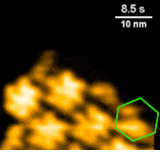Assemblage van virussen gefilmd
Wetenschappers uit Groningen en Madrid hebben uniek beeldmateriaal van de eerste stappen van virusassemblage weten op te nemen. Door een hele snelle tastmicroscoop te gebruiken, konden ze filmen hoe HIV-eiwitten beginnen een virus te vormen. Het blijkt dat het virusvormingsproces helemaal niet zo geordend verloopt. Op het eerste gezicht ziet het er heel willekeurig uit. Toch leidt dit proces uiteindelijk tot een regelmatig virusdeeltje. Door te doorgronden hoe virusassemblage plaatsvindt, kan gerichter worden gezocht naar antivirale geneesmiddelen die specifiek virusvorming verhinderen.

Het humaan immunodeficiëntievirus (HIV) veroorzaakt de ziekte aids, een ziekte waardoor nog steeds meer dan een half miljoen mensen per jaar overlijden. HIV verpakt het virale genetisch materiaal in een capsule van onder andere viruseiwitten. Terwijl met een elektronenmicroscoop hele scherpe plaatjes gemaakt zijn van hoe die eiwitten aan elkaar vast zitten, was er tot voor kort geen methode die kon laten zien hoe ze aan elkaar gaan zitten. De elektronenmicroscoop kan namelijk geen bewegende plaatjes maken. Recent is echter een hele snelle tastmicroscoop op de markt gekomen: de High Speed Atomic Force Microscope (HS-AFM), waarmee je filmpjes kunt maken. Met deze microscoop is het mogelijk om op de tast moleculaire processen te bestuderen, maar het was nog niet gelukt om het zeer dynamische proces van virusassemblage te volgen. Door intensieve samenwerking tussen een onderzoeksgroep gespecialiseerd in HIV van de Universidad Autónoma de Madrid, en de Molecular Biophysics onderzoeksgroep van hoogleraar Wouter Roos van de Rijksuniversiteit Groningen die de snelle microscoop in hun laboratorium hebben, was het mogelijk om virusassemblage live te volgen. “Een technisch hoogstandje”, aldus prof. dr. Wouter Roos van het Zernike Institute for Advanced Materials.
Puzzelen
De onderzoekers hebben aangetoond dat virusassemblage helemaal niet zo geordend verloopt. Het lijkt meer op puzzelen, waar op verschillende plekken puzzelstukjes worden toegevoegd, maar ook weer worden weggehaald als het toch niet lijkt te passen. Op deze manier is het een schijnbaar willekeurig komen en gaan van eiwitten, maar er blijkt toch een logica achter te zitten. Uiteindelijk ligt er een geordend rooster van eiwitten, dat de basis vormt voor het virale deeltje. Waarschijnlijk gebruiken andere virussen een vergelijkbaar proces om een virusdeeltje op te bouwen.
Coronavirussen
Het onderzoeksresultaat is gepubliceerd in het wetenschappelijk tijdschrift ACS Nano. Nu duidelijk is hoe de eerste stappen van virusvorming plaatsvinden, willen de Groningse en Spaanse onderzoekers het vervolg in beeld brengen. Op deze manier hopen ze een compleet beeld te krijgen, beginnend bij de individuele bouwstenen, van hoe een volledig infectieus virusdeeltje wordt gevormd. Naast de fundamentele inzichten in de biologie van virussen die dit werk oplevert, heeft dit ook functionele toepassingen. Als duidelijk is hoe een virusdeeltje zichzelf in elkaar zet, kan er heel gericht gezocht worden naar antivirale geneesmiddelen die gericht zijn op het onderbreken van de assemblage van het aidsvirus. Op termijn is er natuurlijk de hoop dat dit ook voor andere virussen gevonden wordt, zoals bijvoorbeeld voor het coronavirus dat de ziekte Covid-19 veroorzaakt.
Publicatie
Alejandro Valbuena, Sourav Maity, Mauricio G. Mateu and Wouter H. Roos
Visualization of Single Molecules Building a Viral Capsid Protein Lattice through Stochastic Pathways
ACS Nano 2020, Vol. 14, p8724–8734, https://pubs.acs.org/doi/abs/10.1021/acsnano.0c03207
Neem voor meer informatie contact op met
- RUG-woordvoerder Jorien Bakker, j.a.bakker@rug.nl
- Prof. dr. Wouter Roos, w.h.roos@rug.nl
